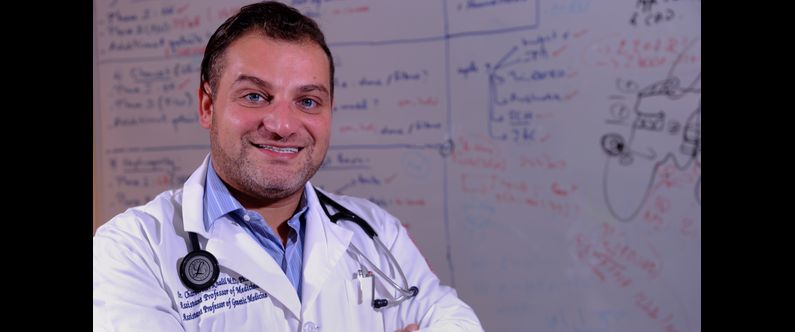WCM-Q research probes efficacy of two main aortic valve replacement procedures
 Dr. Charbel Abi Khalil of WCM-Q led an international team of researchers in a study comparing two different methods of aortic valve replacement.
Dr. Charbel Abi Khalil of WCM-Q led an international team of researchers in a study comparing two different methods of aortic valve replacement.
A global team of researchers, led by Dr. Charbel Abi Khalil at Weill Cornell Medicine-Qatar (WCM-Q), has demonstrated that aortic valve replacement by transcatheter is more effective than the traditional surgical method.
Aortic valve replacement is a lifesaving procedure that involves replacing a damaged or faulty heart valve with a new one, usually made from synthetic material but occasionally from animal tissue. The traditional surgical method of replacement is invasive and involves separating the sternum (breastbone) to provide access to the heart, but from 2002 a minimally invasive procedure emerged that uses a catheter inserted via a blood vessel in the leg or a small incision in the chest to implant the new valve.
Along with his fellow researchers, Dr. Charbel Abi Khalil, Associate Professor of Medicine & Genetic Medicine at WCM-Q and a cardiology consultant, analyzed data from six trials and 7,022 patients with severe aortic stenosis (acute narrowing of the valve) and were able to show that this newer procedure (called transcatheter aortic valve replacement or TAVR) has better outcomes for patients than the older surgical procedure (called surgical aortic valve replacement or sAVR) in terms of mortality rates and other cardiovascular endpoints.
The study looked at outcomes for immediate post-procedural results and two years after the procedure. For the post-procedural results, the data revealed a mean 37 percent risk reduction for adverse effects following transcatheter placement versus the surgical procedure. There was one important caveat, however, which was that placement by transcatheter was associated with a significantly higher risk of leakage between the heart tissue and the valve (called paravalvular leak or PVL) than the more invasive surgical option. Nevertheless, the transcatheter procedure resulted in more favorable outcomes in terms of producing a larger ‘effective orifice area’ (a larger opening in the valve for the blood to move through) and more stable pressure gradients on either side of the valve.
Similar trends were observed two years after the procedure. Both techniques were found to be associated with post-operative functional complications, with up to one-third of patients experiencing problems related to a mismatch between the aortic annulus and the size of the orifice required for adequate blood flow (called patient-prosthesis mismatch), as well as issues with paravalvular regurgitation. Patients who had TAVR had lower risk of patient-prosthesis mismatch than those who had the surgical procedure.
The paper, titled Aortic valve function post replacement of severe aortic stenosis by transcatheter procedure versus surgery: a systematic review and metanalysis, has been published in Scientific Reports, a renowned medical journal.
Dr. Abi Khalil said: “There is clear evidence that there are many advantages to aortic valve replacement by means of transcatheter insertion over the traditional surgical method, but this is counterbalanced by a significantly increased risk of paravalvular leak. However, it remains to be seen how far recent advances in a new generation of prostheses will address these problems. We believe that future research should focus on discovering the associations between the observed problems with TAVR and clinical outcomes.”
Dr. Khaled Machaca, Senior Associate Dean for Research, Innovations, and Commercialization at WCM-Q said: “This research is aligned with WCM-Q’s commitment to conduct research that is translatable and can impact clinical practice toward better treatments.”
The study was supported by Qatar National Research Funds under its National Priorities Research Program Award Number NPRP10-0207-170385 and by the Biomedical Research Program of Weill Cornell Medicine-Qatar (WCM-Q).
The research can be read in full at: https://www.nature.com/articles/s41598-021-91548-x